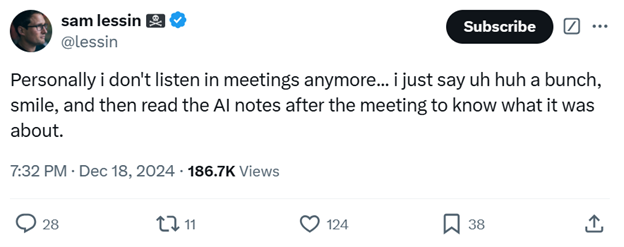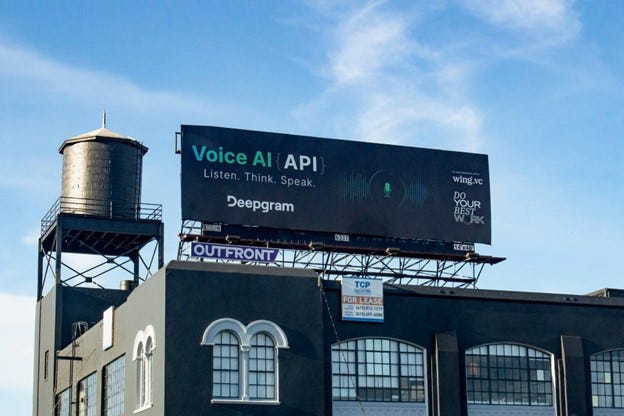We need to talk about Fartcoin. This is the AI-generated memecoin that reached a $2bn+ market cap in early 2025. This coin has zero practical use. It is nevertheless Exhibit A in demonstrating that hype is all you need in the attention economy.
The more interesting element behind Fartcoin is that it was generated by Truth Terminal, an AI chatbot funded by Marc Andreessen. Truth Terminal interacts with crypto communities, hypes coins and creates compelling narratives. It also owns a lot of Fartcoins, making it the first AI centimillionaire.
In essence, Truth Terminal is a window into the future of finance, where AI drives trades, builds reinforcement loops and manufactures increased volatility. Update your priors accordingly.
Narrative has always been key to fundraising. But there has been a fundamental change in the speed at which information can spread across social media, weaponized further by AI bots.
Kyla Scanlon wrote this compelling piece about how 2024 was the year when narrative ate reality in financial markets: “The relationship between narrative and reality truly inverted in 2024. Events used to create narratives. Now, narratives create events.” She goes on to argue that “narrative velocity can become a force for creation rather than just speculation.”
What does this mean (if anything) for venture capital? Are VCs just becoming financial influencers? How should allocators adjust?
Changing media landscape
The world will belong to those who natively combine social media and AI.
The algorithmic approach to attention steepens the power law of media consumption. Hits are bigger. The middle gets hollowed out. The tail in aggregate attracts a higher percentage of attention. This is happening across social media, TV, music and gaming.
It feels like the rise of TikTok was the inflection point, with a focus on short-form video and making the algorithm front and center of the entire strategy. No more feeds based on timelines. Inject that dopamine into my veins as quick as possible.
Individuals are now more likely to get news direct from social media than from reading a news article. The FT shows here how video has now taken over text in terms of consumption. While text-based social media favored the pithy writing of mainstream journalism, the pivot to video places the currency on charisma, energy and delivery: “being first is less important than being hyper-engaging.”
Venture capital is not immune to these changes. VC thought leadership mirrors the platform du jour. Fred Wilson mastered blogs (Web 1.0), while Tom Tunguz inherited this mantle in the halcyon days of early Web 2.0 social media (LinkedIn), and Turner Novak is now king of the memes (TikTok / X). Meme mastery is already a brand development tool for VCs.
Slow’s Sam Lessin went even further here by arguing that VCs should “invest in memes… messages and positioning need to be ready to be transmitted through memes / in short repeatable clips.”
And this is all before VC court retail investors in earnest (with established firms like General Catalyst rumored to be considering an IPO). While the seasoned CIO of an endowment with a strong VC track record may plough through the minutiae of data rooms, a retail investor will probably not. The messaging needs to hit a retail investor over the head. Shock and awe beats thoughtful nuance all day long. Witness the public spat between meme-using DXYZ and long-form Cathie Wood’s Ark. Who made the most compelling argument here?
Even Blackstone recognizes the need to appeal to retail by leaning into pop culture, given that retail & wealth management sources account for 20%+ of all Blackstone management fees. Check our their cringe marketing videos, including their recent foray into country music. Although I do like the Jersey Mike one here. If anything, Blackstone demonstrates that authenticity is critical, including authenticity to communication platform/style. The style here feels incongruous with Blackstone’s brand. Maybe Blackstone should stick to keynotes at SuperReturn?
AI makes location more important
There is however a paradox in that garnering attention through automated meme generation will make direct personal connections & location much more important.
Several VC folk have posted about this phenomenon recently on X:
There is a premium on in-person experiences. Despite recent progress in the globalization of venture capital, being in the Bay Area (and San Francisco in particular) has never been more important. AI is being built here.
An aside on outdoor advertising
This odd combination of high personalisation / memefication and location dependence most visibly physically manifests itself in the venture world on the 101 highway, which carves through Silicon Valley and is home to billboards of the hottest technology companies.
As an industry based on elite “warm intro” networks, this type of advertising was historically considered too low status for VCs (and don’t expect to see a Benchmark billboard any time soon). But VCs are now getting more into the out of home game.
This recent example, showing a company powered by Wing VC, is the more traditional positioning of VC as the rocket fuel behind startups, not the main event.
Menlo Ventures made a claim for firm level branded billboard focused on AI.
Yet the billboard which is most in-line with today’s attention economy is this one from Arising Ventures. The focus is on the individual VC.
Or Slow Ventures’ recent ad.
This expansion into outdoor advertising echoes a similar development in the go-go years of 2005/6 when public market managers were lionized. In particular, New Star Asset Management used to adorn London with ubiquitous billboards of their up-and-coming star managers. It is perhaps of no surprise that New Star is no longer in business…
Does any of this matter to allocators?
You could look at this memeification trend and conclude VCs have become deeply unserious people (compared to say Georges Doriot, the OG VC). This position underplays the power that narrative has always held in markets (see the tulip mania of 1637; or Robert Shiller’s Narrative Economics). It is just that the impact & velocity of narrative is accelerated by AI.
This post is not really relevant to the longstanding LP who has established access to the best VCs in the world. It is more relevant for retail-like allocators as VCs become ever more targeted on retail investors. A higher velocity of content from AI-generated social media is likely to lead to higher volatility. Emerging managers are going to leverage memeification as a tool to try to deliver differentiation / alpha.
AQR’s Cliff Asness has discussed how the public markets are becoming more inefficient, in part caused by social media: “instantaneous, gamified, cheap, 24-hour now including ‘one-day funds’ on your smartphone after getting all your biases reinforced by exhortations on social media from randos and grifters with vaguely not-safe-for-work (NSFW) pseudonyms filtered and delivered to you by those companies’ algorithms that famously push people to further and further extremes. What could possibly go wrong?”
His advice is to have the longest time horizon possible: “a long-term horizon is the closest thing to an investing superpower.” One advantage that VC has over the public markets is that the slow feedback loops of venture capital act as built-in brakes on total memeification in venture capital. So patience pays. In the end, quality always rises to the top.












